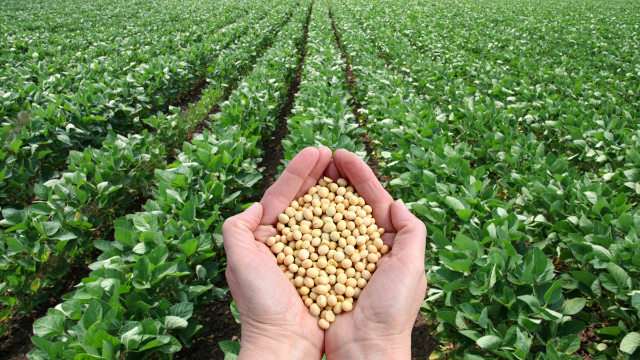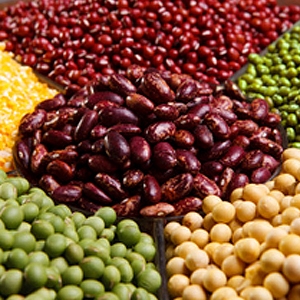The experts all agree we’ll be relying on vegetable protein for our sustenance by 2050. We’re already seeing new products such as meat substitutes made from various plant proteins, but the truth is, some of us have been relying heavily on veggie proteins for centuries…
 Soy Beans: An ancient and venerable plant-based complete human nutrition protein.
Soy Beans: An ancient and venerable plant-based complete human nutrition protein.
Some folks – notably vegetarians, animal rights activists and environmentalists – contend that cattle, pigs, sheep, chickens and other animals we rely on as sources of protein will soon become – or already are – ‘endangered species’. Prices for conventional meats are rising alarmingly as the cost to raise it skyrockets, and environmental activists say conventional ranching is doomed because of its enormous carbon footprint.
Futurists, economists and food scientists say we’ll all be relying heavily – if not exclusively – on plant protein sources by 2050. If the world is still intact more or less as we know it. What are the plant proteins forward-looking entrepreneurs and researchers are already using in what may be regarded as pilot products for the protein foods of the future?
All for one and one for all
As news and marketing hype about plant-based proteins accelerate, we hear more and more about a dazzling array of veggies that are all being used, or considered as key ingredients in plant-based-foods. These include legumes, pulses, beans, peas, lentils, soy beans, peanuts, buckwheat and quinoa, among others. But there’s a secret that makes it simpler and more logical to keep them all straight. They’re all basically the same thing, at the root of it!
Legumes: The mother plant
Legumes are defined by Wikipedia as, “…a plant in the family Fabaceae (or Leguminosae), or the fruit or seed of such a plant. When used as a dry grain, the seed is also called a pulse. […] Legumes are notable in that most of them have symbiotic nitrogen-fixing bacteria in structures called root nodules. For that reason, they play a key role in crop rotation.”
So, what we call beans, peas, lentils, soy beans, quinoa and so on are all really the seeds of legumes – pulses.
‘Complete’ proteins
Conventional meats and a precious few vegetable sources provide with dieticians refer to as a ‘whole’ protein. That means, they provide all 9 0f the amino acids essential to supporting human life. Unfortunately, most legumes don’t deliver a complete protein. That’s why some cultures have developed combinations of beans and grains, which together provide a complete protein. Notable among these ancient and venerable combos are Rice with Beans, Rice with Lentils, and Rice with Tofu.
Soy products
Soy products such as Tofu, Edamame, Tempeh and Miso do deliver a complete protein. For those who are unfamiliar with the less popular ones:
Edamame is the fresh immature form of the Soy bean. Asian folks eat them as snacks, like we eat chips or popcorn.
Tempeh is a fermented Soy product that comes in a firm, moist block, drier than Tofu. It’s usually sliced thin or cubed, and baked or fried. Tempeh can be crumbled and seasoned to resemble ground meat or bacon bits.
Miso is also a fermented Soy product, a paste with lots of salt. It comes in a number of strengths, the darker the colour the stronger. Miso is commonly used as a flavouring ingredient, primarily as a soup base.
Other complete protein sources
Quinoa, Buckwheat, Hemp, Chia and Amaranth seeds all provide a complete protein. But some of these are more palatable and more easily prepared or combined with other ingredients than others. And they vary in the number and amount of other essential vitamins and minerals they contain.
Products on the market now
I think we’ve all heard, by now, of products such as Beyond Meat and Impossible Burgers, which mimic beef and other conventional meats in appearance, texture and flavour. Some do a better job or it than others. Peas and beans are the most popular bases for these products, which are usually enriched with additional nutrients to round out their dietary profiles.
These early entrants in the commercial and retail plant-based meat substitute market have been eagerly embraced by fast food purveyors and supermarket chains as additions to their rosters. But they haven’t been run-away best sellers.
The problem, until recently, with attaining mass adoption of these products has been that they have been priced significantly higher than their ‘real’ counterparts. That’s changing as we speak. Retail prices of conventional meats, from beef to bacon, have soared over the past year, initially because of plant closures due to COVID-19 outbreaks among the employees, and later due to ranchers culling their herds and flocks because they had fewer places to sell their animals during the closures. But prices have continued to rise over the past few months, since the pandemic social and economic restrictions began to ease. And industry insiders say they might not start to moderate until next April. If they moderate at all.
A turning point
We could be at the turning point, when plant-based proteins take ascendancy over conventional meat. If not now, then soon. What more appropriate time than now to get up to speed on plant proteins and the products they’re used in?
~ Maggie J.

